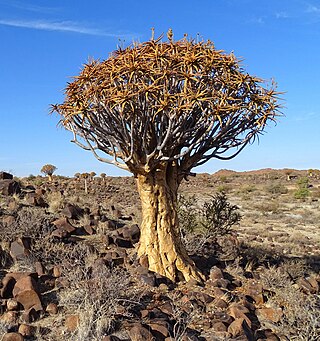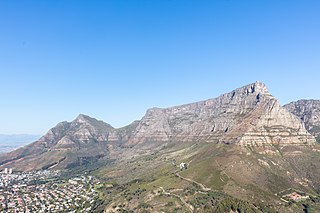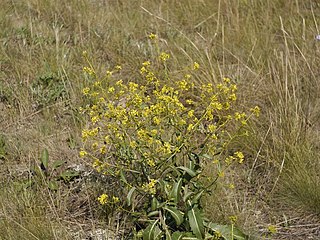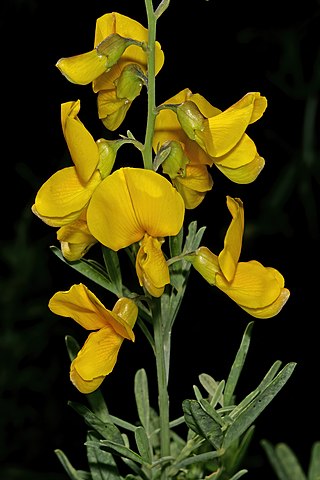
Fynbos is a small belt of natural shrubland or heathland vegetation located in the Western Cape and Eastern Cape provinces of South Africa. This area is predominantly coastal and mountainous, with a Mediterranean climate and rainy winters. The fynbos ecoregion is within the Mediterranean forests, woodlands, and scrub biome. In fields related to biogeography, fynbos is known for its exceptional degree of biodiversity and endemism, consisting of about 80% species of the Cape floral kingdom, where nearly 6,000 of them are endemic. This land continues to face severe human-caused threats, but due to the many economic uses of the fynbos, conservation efforts are being made to help restore it.

Triglochin is a plant genus in the family Juncaginaceae described by Carl Linnaeus in 1753. It includes 25 known species. It is very nearly cosmopolitan in distribution, with species on every continent except Antarctica. North America has four accepted species, two of which can also be found in Europe: Triglochin palustris and Triglochin maritima. Australia has many more.

Aloidendron dichotomum, formerly Aloe dichotoma, the quiver tree or kokerboom, is a tall, branching species of succulent plant, indigenous to Southern Africa, specifically in the Northern Cape province of South Africa, and parts of Southern Namibia.

Table Mountain National Park, previously known as the Cape Peninsula National Park, is a national park in Cape Town, South Africa, proclaimed on 29 May 1998, for the purpose of protecting the natural environment of the Table Mountain Chain, and in particular the rare fynbos vegetation. The park is managed by South African National Parks. The property is included as part of the UNESCO Cape Floral Region World Heritage Site.

The Cape Floral Region is a floristic region located near the southern tip of South Africa. It is the only floristic region of the Cape Floristic Kingdom, and includes only one floristic province, known as the Cape Floristic Province.

The wildlife of South Africa consists of the flora and fauna of this country in southern Africa. The country has a range of different habitat types and an ecologically rich and diverse wildlife, vascular plants being particularly abundant, many of them endemic to the country. There are few forested areas, much savanna grassland, semi-arid Karoo vegetation and the fynbos of the Cape Floristic Region. Famed for its national parks and big game, 297 species of mammal have been recorded in South Africa, as well as 849 species of bird and over 20,000 species of vascular plants.

Conicosia is a genus of succulent plants in the ice plant family native to southern Africa. They are known commonly as narrow-leafed ice plants. These are relatively short-lived perennials with underground stems and tentacle-shaped, dull-pointed triangular leaves. They bear large tubular flowers often exceeding 10 centimeters in width, with up to 250 fringelike petals arranged in a ring around a center with hundreds of stamens. The fruit is a capsule which opens when it gets wet, slowly releasing the hundreds of tiny seeds as they fall out of its drying flesh.
Ice plant or iceplant may refer to:

South Africa, officially the Republic of South Africa, is the southernmost country in Africa. It is bounded to the south by 2,798 kilometres (1,739 mi) of coastline that stretches along the South Atlantic and Indian Oceans; to the north by the neighbouring countries of Namibia, Botswana, and Zimbabwe; and to the east and northeast by Mozambique and Eswatini. It also completely enclaves the country Lesotho. It is the southernmost country on the mainland of the Old World, and the second-most populous country located entirely south of the equator, after Tanzania. South Africa is a biodiversity hotspot, with unique biomes, plant and animal life. With over 62 million people, the country is the world's 23rd-most populous nation and covers an area of 1,221,037 square kilometres. Pretoria is the administrative capital, while Cape Town, as the seat of Parliament, is the legislative capital. Bloemfontein has traditionally been regarded as the judicial capital. The largest city, and site of highest court is Johannesburg.

Wurmbea is a genus of perennial herbs in the family Colchicaceae, native to Africa and Australia. There are about 50 species, with about half endemic to each continent.

Conicosia pugioniformis is a species of succulent plant in the ice plant family known by the common names narrow-leaved iceplant and pigroot. It is native to South Africa and it is known on other continents as an introduced species and sometimes a noxious weed. It is an invasive species on the Central Coast of California, where it is a minor threat to native coastal vegetation, although not as harmful as other species of invasive iceplant. This is a short-lived perennial herb growing from an underground caudex. It can sprout vegetatively from the caudex if its aboveground parts are destroyed. The fingerlike leaves are fleshy, gray-green, hairless, and up to 20 centimeters long. The inflorescence is a solitary, malodorous flower up to 8 centimeters wide. It has rings of up to 250 thin petals.

Anthephora is a genus of plants in the grass family, native to southwest Asia, Africa, the Americas, and various islands.
Cassionympha detecta, the Cape brown, is a butterfly of the family Nymphalidae. It is found in South Africa, in the mountains of the Western Cape from Cederberg to Swartberg down to the coast, then along the south-east coast and hills to the Eastern Cape and into Great Karoo.

Brassica elongata, the elongated mustard or long-stalked rape, is a species of the mustard plant that is native to parts of Central Europe, Eastern Europe, the Balkan Peninsula, the Caucasus, Morocco and parts of Central Asia. Through plant invasion this species has become naturalized in many other parts of the world. Some of these naturalized regions include South Africa, North Western Europe, Australia and North America. Given the wide range of climate and ecological conditions of these regions, B. elongata has been able to disrupt the ecosystems of their native plant habitats and has been label as an invasive species in many of its naturalized zones. In North America, this species is often found as a roadside weed in the southwestern states, particularly in the state of Nevada. Studies allude that the Cruciferae might have migrated through the Bering land bridge from what is now Central Asia. Commonly known as the long-stalked rape or as langtraubiger Kohl in German, this species is a close cousin to Brassica napus (rapeseed) and a secondary genetic relative to B. oleracea (kale). As a close genetic species of the rapeseed, the long-stalked rape has one of the highest counts of accumulated polyunsaturated linoleic and linolenic acid. Both compounds are heavily used to manufacture vegetable oils. Brassica elongata has the propagative potential of turning into a horticultural product from what is currently a noxious weed.

The Hantam National Botanical Garden is situated outside Nieuwoudtville. It is the first National Botanical Garden in the Northern Cape. The main section of the garden is 5 km south-east of the town, neighbouring the Oorlogskloof Nature Reserve.

Calobota is a genus of flowering plants in the legume family, Fabaceae. It includes 16 species native to North Africa and southern Africa. It belongs to the subfamily Faboideae.

Stapelia hirsuta, common name starfish flower or carrion plant, is a species of flowering plant belonging to the family Apocynaceae.

Serruria elongata or long-stalk spiderhead is a plant belonging to the protea family. It is an erect, hairless shrublet of 1–1½ m (3½–5 ft) high with densely set, alternate, finely divided leaves lower down the plant, with needle-like segments. On top of an up to 30 cm (12 in) long inflorescence stalk are several, loosely arranged heads of pin-like, densely silvery-haired flower buds, each of which opens with four curled, magenta pink corolla lobes. The species is endemic to the southern Western Cape province of South Africa. It flowers during the southern hemisphere winter and early spring, between June and September.
Serruria altiscapa, the stately spiderhead, is a flower-bearing shrub that belongs to the genus Serruria and forms part of the fynbos. The plant is native to the Western Cape and occurs at Blokkop in Villiersdorp as far as the Hottentots-Holland Mountains.

Lapeirousia pyramidalis is a species of geophyte in the genus Lapeirousia. It is endemic to the Cape Provinces of South Africa. It is also known as the pyramid kabong.


















